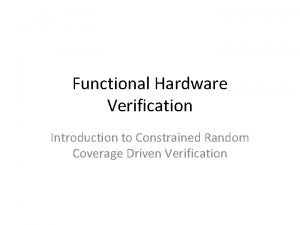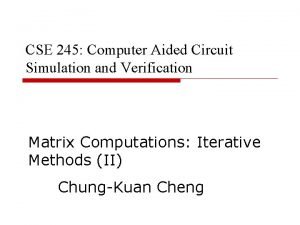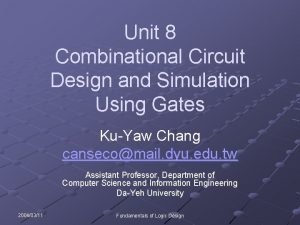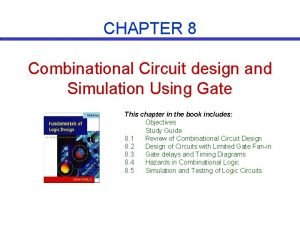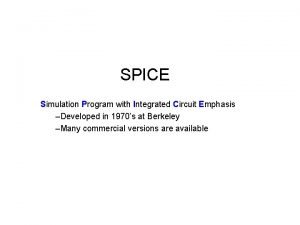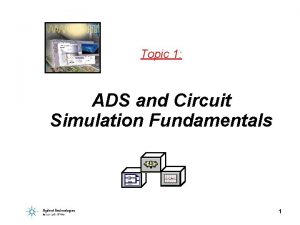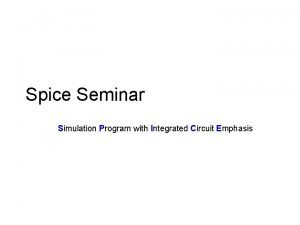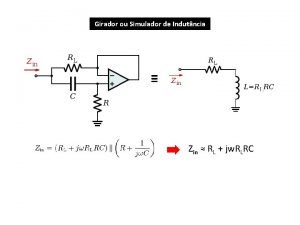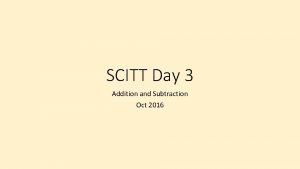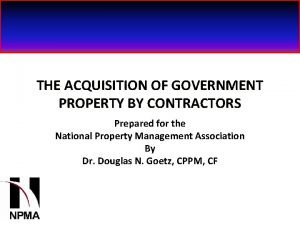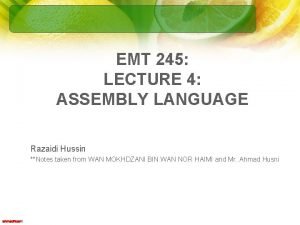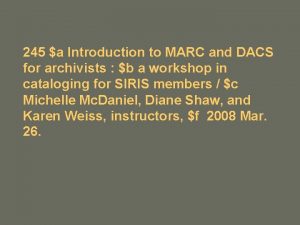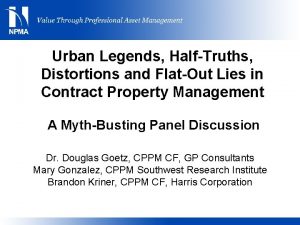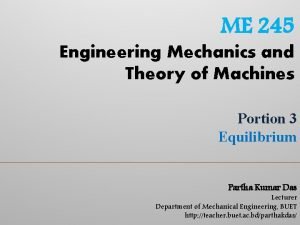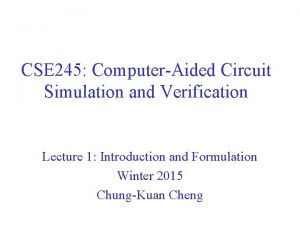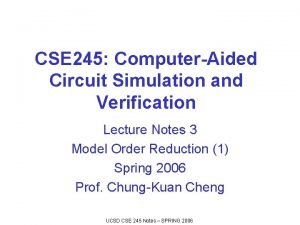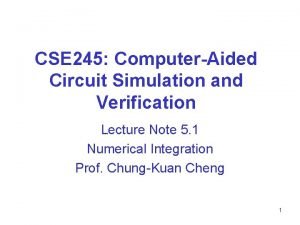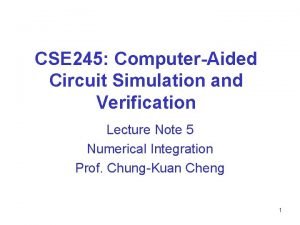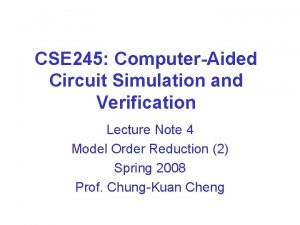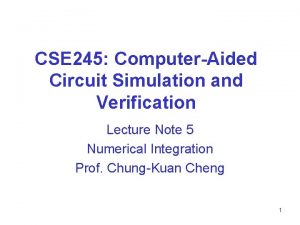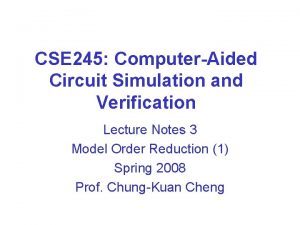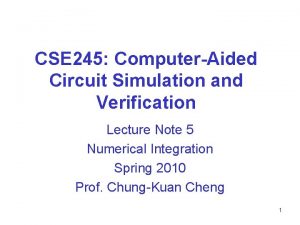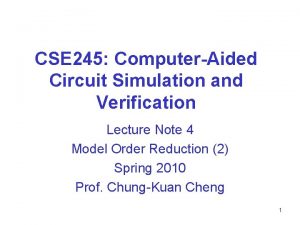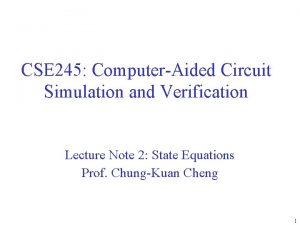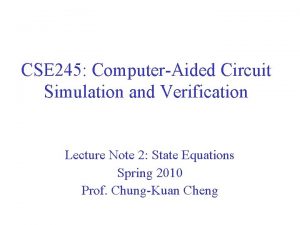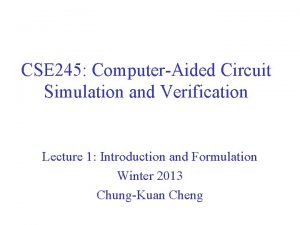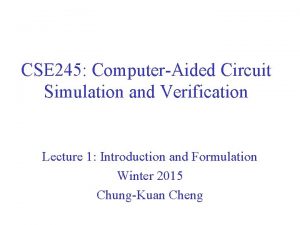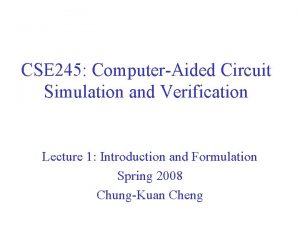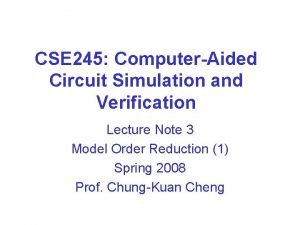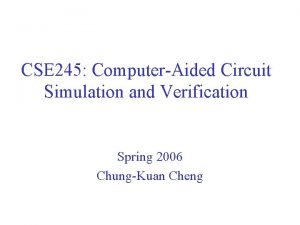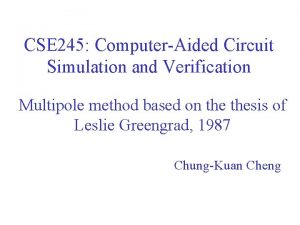CSE 245 ComputerAided Circuit Simulation and Verification Lecture






















- Slides: 22

CSE 245: Computer-Aided Circuit Simulation and Verification Lecture Notes 6 Numerical Integration Spring 2006 Prof. Chung-Kuan Cheng UCSD CSE 245 Notes – SPRING 2006

Numerical Integration: Outline • One-step Method for ODE (IVP) – Forward Euler – Backward Euler – Trapezoidal Rule – Equivalent Circuit Model • Convergence Analysis • Linear Multi-Step Method • Time Step Control UCSD CSE 245 Notes – SPRING 2006

Ordinary Difference Equaitons N equations, n x variables, n dx/dt. Typically analytic solutions are not available solve it numerically UCSD CSE 245 Notes – SPRING 2006

Numerical Integration Forward Euler Backward Euler Trapezoidal UCSD CSE 245 Notes – SPRING 2006

Numerical Integration: State Equation Forward Euler Backward Euler UCSD CSE 245 Notes – SPRING 2006

Numerical Integration: State Equation Trapezoidal UCSD CSE 245 Notes – SPRING 2006

Equivalent Circuit Model-BE • Capacitor + + + C - 26 October 2021 - 7

Equivalent Circuit Model-BE • Inductor + + + L 26 October 2021 8

Equivalent Circuit Model-TR • Capacitor + + + C - 26 October 2021 - 9

Equivalent Circuit Model-TR • Inductor + + + L 26 October 2021 10

Summary of Basic Concepts Trap Rule, Forward-Euler, Backward-Euler All are one-step methods xk+1 is computed using only xk, not xk-1, xk-2, xk-3. . . Forward-Euler is the simplest No equation solution explicit method. Backward-Euler is more expensive Equation solution each step implicit method most stable (FE/BE/TR) Trapezoidal Rule might be more accurate Equation solution each step implicit method More accurate but less stable, may cause oscillation UCSD CSE 245 Notes – SPRING 2006

Stabilities Froward Euler 26 October 2021 12

FE region of absolute stability Forward Euler ODE stability region Im(z) -1 Difference Eqn Stability region 1 Re(z) UCSD CSE 245 Notes – SPRING 2006 Region of Absolute Stability

Stabilities Backward Euler 26 October 2021 14

BE region of absolute stability Backward Euler Im(z) -1 Difference Eqn Stability region 1 Re(z) Region of Absolute Stability UCSD CSE 245 Notes – SPRING 2006

Stabilities Trapezoidal 26 October 2021 16

Convergence • Consistency: A method of order p (p>1) is consistent if • Stability: A method is stable if: • Convergence: A method is convergent if: Consistency + Stability Convergence UCSD CSE 245 Notes – SPRING 2006

A-Stable • Dahlqnest Theorem: – An A-Stable LMS (Linear Multi. Step) method cannot exceed 2 nd order accuracy • The most accurate A-Stable method (smallest truncation error) is trapezoidal method. UCSD CSE 245 Notes – SPRING 2006

Convergence Analysis: Truncation Error • Local Truncation Error (LTE): – At time point tk+1 assume xk is exact, the difference between the approximated solution xk+1 and exact solution x*k+1 is called local truncation error. – Indicates consistancy – Used to estimate next time step size in SPICE • Global Truncation Error (GTE): – At time point tk+1, assume only the initial condition x 0 at time t 0 is correct, the difference between the approximated solution xk+1 and the exact solution x*k+1 is called global truncation error. – Indicates stability UCSD CSE 245 Notes – SPRING 2006

LTE Estimation: SPICE • Taylor Expansion of xn+1 about the time point tn: • Taylor Expansion of dxn+1/dt about the time point t n: • Eliminate term in above two equations we get the trapezoidal rule LTE UCSD CSE 245 Notes – SPRING 2006

Time Step Control: SPICE • We have derived the local truncation error the unit is charge for capacitor and flux for inductor • Similarly, we can derive the local truncation error in terms of (1) the unit is current for capacitor and voltage for inductor • Suppose ED represents the absolute value of error that is allowed per time point. That is together with (1) we can calculate the time step as UCSD CSE 245 Notes – SPRING 2006

Time Step Control: SPICE (cont’d) • DD 3(tn+1) is called 3 rd divided difference, which is given by the recursive formula UCSD CSE 245 Notes – SPRING 2006
 Constrained random verification
Constrained random verification Cse simulation oy
Cse simulation oy 01:640:244 lecture notes - lecture 15: plat, idah, farad
01:640:244 lecture notes - lecture 15: plat, idah, farad Combinational circuit design and simulation using gates
Combinational circuit design and simulation using gates Simulation and testing of logic circuits
Simulation and testing of logic circuits Simulation program with integrated circuit emphasis
Simulation program with integrated circuit emphasis Ads circuit simulation
Ads circuit simulation Bridged t network transfer function
Bridged t network transfer function Microwave simulation software
Microwave simulation software Simulation program with integrated circuit emphasis
Simulation program with integrated circuit emphasis Simulador
Simulador Use a number line to solve 245-137
Use a number line to solve 245-137 245 angle
245 angle Prime factorization 120
Prime factorization 120 What is line angle in dentistry
What is line angle in dentistry Far 52-245-1
Far 52-245-1 Aj 245
Aj 245 Emt 245
Emt 245 250 yüzlüğe yuvarlama
250 yüzlüğe yuvarlama Marc 245 example
Marc 245 example What does dcma daco stand for
What does dcma daco stand for Simple machines engineering mechanics
Simple machines engineering mechanics 245 nömrəli tam orta məktəb
245 nömrəli tam orta məktəb
